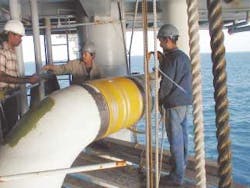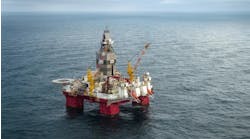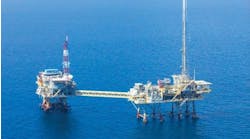William Furlow • Houston
Observing multi-phase flow
To better study the nature of multi-phase flow, engineers at the Southwest Research Institute (SwRI) in San Antonio, Texas, have developed a probe to look inside a pipeline flowing under pressure. André Barajas, a senior research engineer with SwRI, said the tool was assembled using off-the-shelf materials and funded internally.
The tool consists of two main parts. The probe is a pressure-containing housing with a sapphire window at its tip. The probe can withstand pressure up to 3,600 psi and temperatures as high as 150° F. Inserted into the probe is a borescope that includes a focusable lens and a light source. Using the sapphire window as a porthole, the borescope can take still pictures or video footage of the inside of a pipeline as the line flows under pressure.
Barajas said the industry's increasing need to understand multi-phase flow drove the design and construction of this unique tool. There are various methods for predicting the behavior of multi-phase fluids, but this tool verifies predictive models. By actually observing how the multi-phase fluids behave inside the pipeline, engineers can better understand how hydrates form in long pipelines. The tool has other applications as well.
Barajas gave the example of placing the borescope downstream of a cyclone separator, designed to remove liquid from a gas stream. The camera showed exactly when a mist of water passed through the separator so it could be adjusted to work properly. In other experiments, Barajas said the camera showed how hydrates form in a pipeline. Specifically, Barajas said, he learned that the ice crystals attach themselves to the top and sides of a flowline first, allowing a gas and hydrate slurry to continue flowing along the bottom third of the line.
The probe is designed to be installed on any pipeline with at least 3/4-in. ball valve access. The tool was designed to be portable, and Barajas said there are plans to take it into the field for future operations.
Repair of platform riser using Clock Spring
The Clock Spring composite repair system was selected for riser repair on a platform located offshore Colombia. The platform has been in service for more than 23 years. During a routine inspection of the riser, corrosion was found in two separate locations. The 24-in. riser has a 0.5-in. wall, and is made of grade X-42 pipe. One of the defects was located at the transition from straight pipe to a factory bend. The second occurred at a riser clamp on a stretch of an area of straight, vertical pipe. The corrosion extended over approximately 50% of the wall and required repair. In both cases, the corrosion affected a girth weld.
The Clock Spring repair solution was selected primarily because it requires no "hot" work. From a safety standpoint, this offers an advantage when working on a production platform.
The composite repair system has three major components:
null
- A composite sleeve of unidirectional e-glass fibers and a polymer base, which acts as the strength member
- An adhesive, to secure the repair
- A load transferring material, to transfer the load from the defect to the composite sleeve.
The repair process is very straightforward. The sleeve is wrapped around the riser and then bonded to the pipe at the defect locations where it provides reinforcement.
The first repair area was at a location where straight pipe transitions to a bend. The corrosion was generally restricted to the straight pipe with limited corrosion in the bend. To begin the repair, the weld cap was ground down in areas where it projected slightly above the straight pipe. This would provide a uniform surface for the repair. Two Clock Spring reinforcing sleeves were installed on the straight pipe and a third, 2-in. band attached to the weld area. The entire repair took less than two hours.
The second repair was located in a vertical section of the riser. The corrosion at this location affected the weld zone. The pipe surface was first cleaned, then covered with an anticorrosive coating prior to the installation of the patch. The coating was left over night so it would have time to fully cure. On the following day, the corrosion was packed with the filler material. Then a single wrap mold was installed to hold this material in place until it cured. After the filler material cured, the mold was removed. The pipe was then dressed back to its original contour and the repair made using the "weld bridge" technique.
Weatherford tapped for Matterhorn
Weatherford International will install 13 chrome alloy and vacuum insulated production tubulars and accessories on Total's Matterhorn field. Matterhorn is located in the Gulf of Mexico on Mississippi Canyon block 243 in 2,816 ft of water.
The field will be developed with a nine-slot Sea Star TLP and will initially support seven dry-tree surface completions. Weatherford's Tubular Running Services group in Lafayette, Louisiana, will provide the personnel and equipment using Weatherford's dual completion tools with Micro-Grip non-marking technology. The tubing strings will consist of 3.5-in. or 4.5-in. 13Cr tubing, 4.5-in. or 5.5-in. VI tubing, and 3.5-in. by 1.9-in. or 4.5-in. by 1.9-in. mud line dual strings. Seven electric/hydraulic control lines will be run simultaneously and attached to the tubing strings with newly designed clamps and protectors. The Matterhorn completion program is slated to start in summer 2003.
J. Ray McDermott to install Shah Deniz pipelines
A subsidiary of J. Ray McDermott has been awarded a pipelay contract by BP Shah Deniz Exploration Ltd. The contract is for the Stage 1 development of the Shah Deniz field in the Azerbaijan sector of the Caspian Sea and is valued at over $80 million. The scope of work includes the installation of two 90-km offshore gas transportation pipelines from the Shah Deniz Alpha platform to the Sangachal onshore terminal, pipe-line tie-ins to the platform, diving work, and all pre-commissioning activities. The pipelines include a 26-in. trunkline and a 12-in. line, with an additional 4-in. piggyback pipeline on top. The pipeline installation will be performed in 2005 with tie-in and completion scheduled during 2006.
Sonsub's Innovator conquers loop
During the recent wave of loop current incidents in the Gulf of Mexico, Sonsub's Innovator ROV systems were forced to cope with more than 3.5-knot conditions. The ROV, onboard the Discovery Spirit, was able to continue operations for its client despite heavy loop currents. In fact, during the peak periods of the loop currents, the Innovator 8 made an extended dive to recover the drillship's BOP. Additionally, Innovator 9 working onboard the HOS Innovator was called to the Mad Dog field in the Gulf of Mexico. There the ROV installed an emergency plug on the Diamond Ocean Confidence. These operations required the ROV to work close to the water's surface, in the worst currents.




